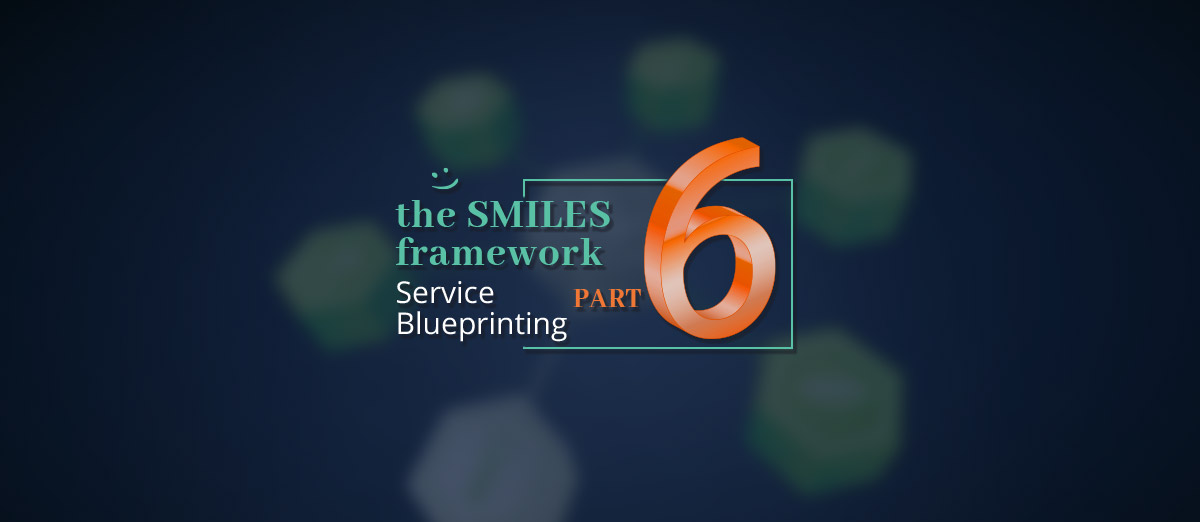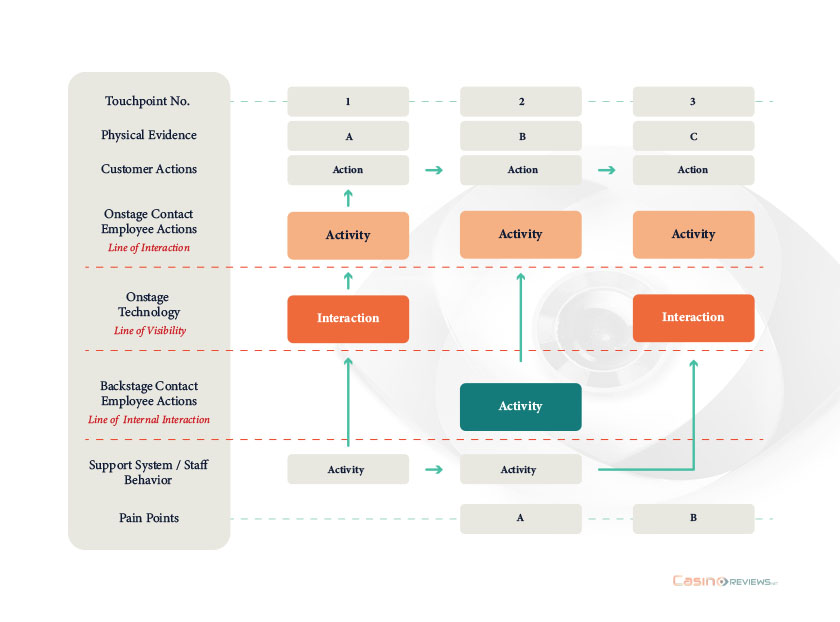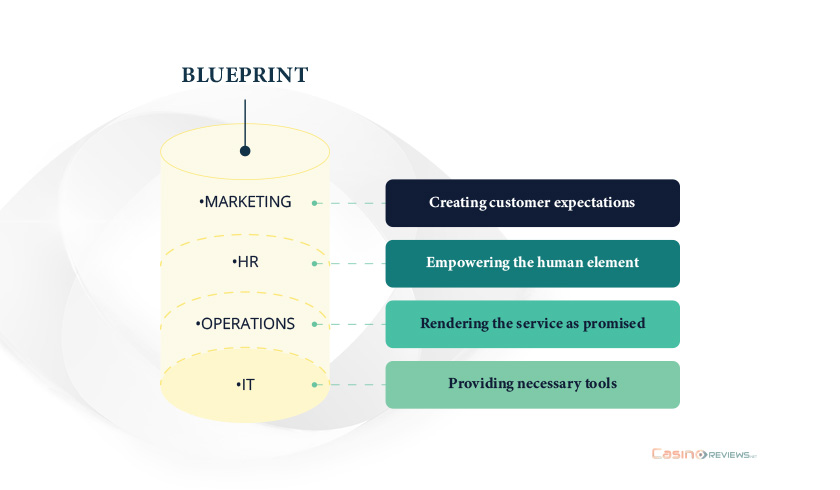The Role of Service Blueprinting in Creating High-Quality Customer Experiences in Casinos

Service blueprinting is a complex form of flowcharting the service delivery process. A service blueprint specifies in detail how and where casino customers interact with your organization. One unique aspect of blueprinting is that it depicts the flow of services the way a customer sees it. Creating a service blueprint is a participatory exercise that brings together employees across functions and departments. One key benefit of blueprinting is that casino employees can relate “what I do” to the service viewed as an integrated whole, thereby enhancing customer orientation and employee engagement. Blueprints are widely used to identify fail points in service delivery and to establish “golden touchpoints” to differentiate a service provider from its competitors.
Introduction
Of all the tools available for service design, service innovation, and service processes, none are as effective in highlighting the various service components and their interrelationships as service blueprinting. Created by G. Lynn Shostack in 1984, service blueprinting quickly became the focus of attention in academia and in service businessesi. When correctly designed, a service blueprint depicts the entire end-to-end service delivery system from the customer’s perspective. Offering several key benefits, service blueprints are increasingly used to design new services, to improve the quality of existing services, and to identify points of differentiation from the competition. At least three of the six Macau casinos have reaped the benefits of service blueprints.
What Is a Service Blueprint?
A service blueprint is “a picture or map that accurately portrays the service system so that the different people involved in providing it can understand and deal with it objectively regardless of their roles or their individual points of view.”ii It could also be described as a service roadmap—a tangible, visual document that lays out where and how your customers interact with your casino. Usually, multiple stakeholders are involved in creating a service blueprint. This participatory nature of blueprinting is a great way to build teams and share expertise. The blueprint, in essence, is an information-laden document made up of six components that, when drawn up together, helps make the customer-company relationship and the customer experience crystal clear (see Figure 1). The six components of a service blueprint that impact service delivery at each touchpoint are:
- Customer actions, comprising of all of the steps that customers take as part of the service delivery process.
- Onstage technology actions, consisting of the actions by customer-facing technology (e.g., online gaming websites or passing through metal detectors in some land-based casinos) that customers experience as part of the service process.
- Onstage/visible contact employee actions, comprising of the behaviors of frontline contact casino employees that occur as part of a face-to-face encounter with customers.
- Backstage/invisible contact employee actions, made up of the non-visible interactions with customers, such as telephone calls and other activities employees undertake to prepare to serve customers or that are part of their role responsibilities.
- Support staff, processes, and IT comprise of all employees, activities, processes, and systems whose functions, carried out in the background, are crucial to the carrying out of services processes.
- Physical evidence represents all the tangibles (e.g., building, employee uniforms, and ambient conditions) that customers are exposed to during their contact with a company.
The key action areas of a service blueprint are separated by three horizontal lines. First is the line of interaction, representing direct interactions with the customer. Anytime a vertical line crosses this horizontal line, direct contact between the customer and the organization has taken place. The next horizontal line is the line of visibility. This line separates all activities visible to the customer from those that are not visible. This line also separates what the contact employees do onstage from what they do backstage. The third line is the line of internal interaction. This line separates the activities of the contact employees from those of other service support staff. Vertical lines cutting across the line of internal interaction are considered internal service encounters.

Figure 1: Components of a Service Blueprint
Rationale for Creating Service Blueprints
Most gambling businesses typically have many concurrently running programs to monitor and measure operational and customer service effectiveness. However, these programs tend to be carried out in an isolated and disparate manner and are typically presented from the operator’s—not customer’s—perspective. In the case of most gaming businesses, an understanding of the service system from the vantage point of the customer is often lacking. A service blueprint brings into focus the interrelationships across various initiatives and helps prioritize various activities based on how they impact the customer.
When adopted across the organization, service blueprints enhance coordination between Operations, Marketing, and HR by providing a common frame of reference. This commonality in perceptions makes it possible to describe and discuss service issues in an unambiguous and objective manner.
More specifically, service blueprinting helps in assessing the existence and effectiveness of various marketing and operational tools and customer service initiatives so that the right customers can be retained and revenues can be increased.
Prerequisites
Service blueprinting is not an activity that can be performed perfunctorily. Done properly, blueprints demand a lot of time and attention. For blueprints to yield their full potential, senior management within the casino needs to abide by four key guidelines:
- Senior executives need to understand and appreciate the concepts and processes inherent in service blueprinting. Better yet, they should assume ownership of the service blueprinting initiative.
- Executives need to be involved in collectively developing a blueprint or, at the very least, play a big part in gaining consensus across the enterprise on its components and flow.
- There needs to be willingness at the top management level to incorporate segment-specific optimal blueprints into the corporate DNA.
- Post-adoption, the optimized blueprints should be treated as living documents with which to plan and orchestrate the customer experience across key segments.
Building the Service Blueprint
Many of the benefits of service blueprinting are realized in the very process of designing the blueprint. During the design process, the blueprint concept becomes clearer, a shared service vision emerges, and the hitherto hidden complexities of the service are brought to the surface. Ideally, the service blueprint should be designed using inputs from customer research. Service blueprint design should be a cross-functional activity and typically include representatives from Marketing, Operations, Human Resources, and Facilities Design. It is a good idea to include a few frontline employees in the design process.
Creating a service blueprint involves six main steps. These steps are:
- Identifying the service process to be blueprinted.
- Identifying the customer segment for which the blueprint is designed.
- Mapping the service process from the customer’s point of view.
- Mapping the contact employee and/or technology actions both onstage and backstage.
- Linking contact activities to their respective support functions.
- Adding the physical evidence that the customer gets to see at each touchpoint.
Having designed the service blueprint, the next logical step is to identify (diagnose) and fix the fail points (or customers’ pain points) evident in the blueprint. These are touchpoints where the delivered experience clearly falls short of what the customer would normally expect. Fail points can be identified through voice of the customer research (VoC) or by the blueprint designers “walking in the shoes of the customer,” thus literally making the journey that the typical customer would make.
Fixing the fail points is best accomplished by using any of the standard quality improvement methodologies such as Six Sigma, Lean Thinking, Poka-Yokes, or the Theory of Constraints. The gambling operator can choose the methodology it is most comfortable working with.
Once the fail points are fixed, the company needs to look at ways in which the journey could be made better or even more enjoyable for the customer. This is the ideation phase following blueprint design. The ideation process involves deciding on the best possible experience based on answers to questions such as, “Who is the customer,” “What is (are) the customer’s real goal(s) in using our product/service,” and “What will make the customer truly happy?” Asking these critical questions ensures that due attention is paid to the customer experience at each touchpoint.
Oftentimes ideation can result in a journey that may be ideal for the customer but impractical for the provider. This is where the journey optimization comes in. Key tenets guiding optimization are (1) Knowing your customer; (2) Treating different customer segments differently based on their needs and value to the experience provider; (3) Utilizing technology wherever possible to better connect to customers; (4) Taking an end-to-end process view of the entire customer journey; and (5) Ensuring that at least some parts of the customer journey are designed with the objective of creating strong positive emotions in the minds of customers.
Optimization relates the sum-total of the costs of serving the customer at each touchpoint with the total benefits or value the company derives from providing the end-to-end customer experience. Competitive considerations also play a big role in determining the final service blueprint.
The optimized journey blueprint then needs to be implemented, and its impact on customers can be ascertained. Qualitative and quantitative market research, as well as some advanced techniques in neuromarketing and metaphor elicitation, can be employed in assessing the effectiveness of the service blueprint and its impact on the quality of customer experience.
Advantages
Compared to other initiatives available for designing and delivering the customer experience (such as simple service flowcharting and quality function deployment), service blueprinting has several unique advantages, both procedural and outcome-oriented:
- Service Blueprints provide a common point of discussion for service improvement, thus making explicit decision makers’ and employees’ notions of what constitutes the customer experience and what it ought to be.
- Service Blueprints give employees an overview of the entire service process—both current and future – so they can better appreciate how their roles fit into the integrated whole.
- Service Blueprints generate insights into the various role and relational interdependencies throughout the entire organization (e.g., IT, HR, Marketing, and Gaming), thereby highlighting the interrelationships across business processes. These interdependencies are illustrated in Figure 2.
- Service Blueprints reveal all the touchpoints that are critical in meeting customer needs and help in identifying likely points of service failure.
- Service Blueprints bring to the fore key operational, human resources, and marketing issues associated with the customer experience.
- Service Blueprints alert management to areas where costs can be cut, revenues can be increased, and profits can be maximized.
- Most importantly, Service Blueprints help identify, design, and execute the ideal customer experience.

Figure 2: Role and Relational Interdependencies Uncovered in Service Blueprints
Conclusion
With few exceptions, customer experience has become the new battleground for gambling companies the world over. On the one hand, customers have unprecedented choices of where to spend their gaming dollar. On the other hand, it seems like the total pool of gamblers is stagnating, if not shrinking. Dealing with these headwinds requires a mindset and culture change on the part of gaming executives. The “build it, and they will come” orientation that served some operators well in markets such as Australia and Macau is now well and truly obsolete.
The new normal involves creating a truly customer-centric culture across the entire organization. Voice of the customer needs to be captured at all possible touchpoints. This voice then needs to manifest itself in charting the right customer experience—from fixing fail points uncovered in service blueprints to journey ideation and optimization. We are well and truly in the era of customer experience; companies desirous of success in this unchartered territory should not just talk about customer experience; they need to fund it, implement it, and keep monitoring it.
References:
i Shostack, G. Lynn (1984), “Designing Services that Deliver,” Harvard Business Review, (March-April), pp. 133-139.
ii Zeithaml, V.A., Bitner M.J., and Gremler, D.D. (2006). Services Marketing: Integrating Customer Focus Across the Firm. New York: McGraw Hill.
Read more:
- The Role of Segmentation in Customer Experience
- Market Orientation and Value-Based Customer Experience in Casinos
- How to Provide Your Customers the Best Casino Experience – The SMILES Framework
- Internal Marketing – The Key to Delivering Great Customer Experience in Casinos
- The Role of Linkage Analysis in Delivering Positive Customer Experience for Casino Players
- The Role of Emotional Competence in Delivering and Improving Casino Customer Experience





Review this Blog
Leave a Comment
User Comments
comments for The Role of Service Blueprinting in Creating High-Quality Customer Experiences in Casinos